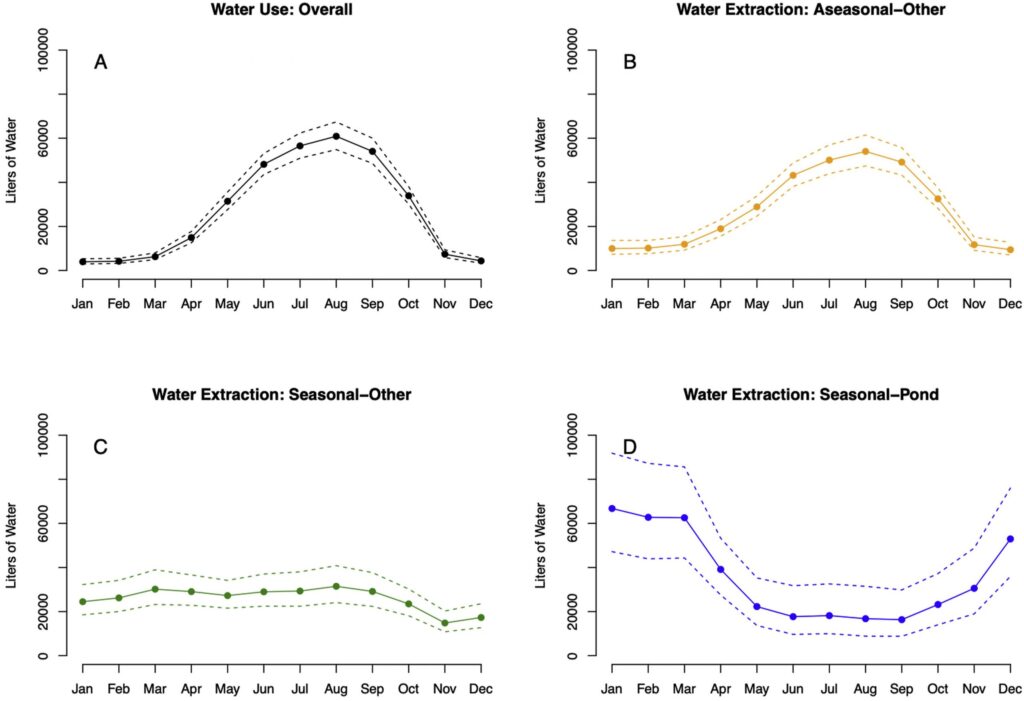Amy Fingerle is a new grad student in the #BerkeleyFreshwater group, and will be co-advised by Stephanie and Ted. Before starting graduate school, Amy worked for the Salmon River Restoration Council. Amy dissertation research will focus on identifying spring Chinook strongholds in the Salmon River and strategies for conserving spring Chinook in the Salmon River and beyond.
Lab News
How Much Water Does Cannabis Use?
Our new paper in the Journal of Environmental Management, led by Dr. Chris Dillis, explores seasonal patterns of water use by cannabis in Northern California. Read the paper here!

Water Use vs. Water Extraction. Overall monthly water use estimates (A) are plotted along with monthly water extraction estimates, based on source type and storage type (B–D). Model estimates are provided for median farm size (cultivation area = 1098 m2). Dashed lines depict 95% confidence intervals for the mean estimate. Farms reporting aseasonal water sources in combination with ponds for storage are omitted from this figure as they represented less than 2% of all observations.
Welcome to Dr. Denise Colombano!
Dr. Denise Colombano is a new postdoc in the #BerkeleyFreshwater group, and will be co-advised by Stephanie and Albert. Denise received a Delta Science Postdoctoral Fellowship to explore fish community responses to variable climate regimes, flows, and habitats along an estuarine gradient. Welcome, Denise!
Protecting California’s Aquatic Biodiversity in a Time of Crisis
Peter Moyle (UC Davis), Jeneatte Howard (The Nature Conservancy), and Ted Grantham argue that now is the time to consider the importance of biodiversity protection in an article on the CaliforniaWaterBlog.
College of Natural Resources Highlights the Role of Cooperative Extension Specialists in Addressing Climate Change
The latest issue of Breakthroughs, the Magazine of the College of Natural Resources at UC Berkeley, highlights the work of Assistant Cooperative Extension Specialists Dan Sanchez, Ellen Bruno, and Ted Grantham. Read the story here.
What Does Drought Mean for Endangered California Salmon?
Increased frequency and severity of droughts threatens California’s endangered salmon population—but pools that serve as drought refuges could make the difference between life and death for these vulnerable fish. Read more in our new study, led by Ross Vander Vorste, published in Global Change Biology!
Streamflows Aren’t What They Used to Be
Human activities have caused flows in many of the Nation’s streams and rivers to be different from what they would be naturally. A new USGS study reports that, at a national scale, human management of land and water resources have modified natural patterns of streamflow along an estimated 1.2 million stream miles—more than one-third—of the Nation’s streams and rivers.
Biodiversity benefits of restoring wetlands
Hi! I am Zhenhua Sun, visiting Ph.D. student in the lab. During my stay I have been gathering data on water quality and macroinvertebrate community composition in ponds and wetlands across the globe. Our study areas and collaborators span Argentina, Canada, France, Ireland, Norway, Slovakia, Sweden, Switzerland, UK, and the US!
In particular, we are asking whether natural, agricultural, and highway ponds differ in the contributions they make to landscape-scale biodiversity. In turn, this could in stormwater pond design, so that these elements of green infrastructure maximize ecosystem benefits.
Stay tuned for a forthcoming paper on the topic!

Updates – Sept & Oct 2019
- The lab is full steam ahead this Fall 2019! We started scouting sites for our CADFW Delta restoring wetlands project, we are building traps for the field experiment at Pinnacles, and we are making progress in our data-driven projects (river-reservoir dynamics, CA drought, created wetlands, metacommunity stability).
- Guillermo and Kyle presented at the California chapter of the Society for Freshwater Science (CalSFS) – California Bioassessment Workgroup (CABW) meeting at UC Davis.
- Albert coauthored a review in Science, with SESYNC director Margaret Palmer, on the importance of flow regime for river ecosystem restoration. Check it out here! [see associated interview].
- The lab hosted Sebastien Rauch and Ekaterina Sokolova, who visited us from Chalmers University of Technology, Sweden.
- The lab also hosted John Sabo, director of Future H2O (Arizona State University), with whom we continue to collaborate on spectral methods and hydrologic regime shifts.
- Albert joined the editorial board of Conservation Letters, a leading journal on interdisciplinary conservation science.
More soon! 🙂
TEDx talk by Jessie Moravek
Jessie Moravek, Ph.D. student in the lab, gave a TEDx talk at the TEDxFulbrightGlasgow event last June, on hydropower development and its impacts on ecosystems and people. The talk is online now. Check it out here!
